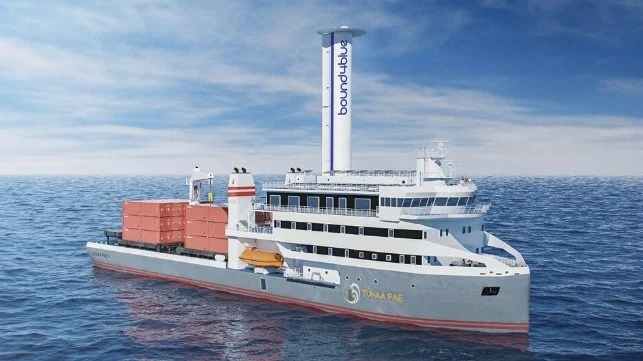Advanced Design with Suction Sail for Unique Tahiti Cargo-Passenger Ship

Designs were presented for a unique combination cargo passenger ship that will launch in 2026 providing critical service between Tahiti and the remote Austral Islands. Designed to be a vital supply ship that also supports the development of tourism to the pristine islands, the vessel also seeks to employ a range of new technology including a first-of-its-kind suction sail installation.
Société de Navigation des Australes TUHA’A PAE has been providing service to the Austral Islands, and most notably the island of Rapa which has no airport, for nearly 55 years. The company has a contract to make at least 26 annual trips and at least 12 annually to Rapa. Four years ago, in 2020, the company that operated occasional cruises decided to expand the business as part of an effort to support the development of the remote islands.
The new vessel to be known as the Ba Pae e Hiro is designed to carry both vital supplies as well as up to 200 tourists on its voyages from Tahti and is being developed in a project with the support of the French government. It meets critical goals for local fleet renewal, supporting and opening the Australes, delivering the cruise business with tourism revenues, supporting employment, and critically meeting sustainability goals.
Designed by Cotenaval of Spain with consulting by ECCO of France, designs for the 292-foot (89-meter) vessel call for a broad range of state-of-the-art systems and an optimized design to reduce energy consumption, emissions, and maintenance costs. Additionally, flexibility and quick loading and unloading are key to the operations along with comfortable, modern accommodation areas for the tourists. The vessel is to be built by Armon Shipyard in Virgo, Spain.

The new vessel will replace a small passenger-cargo ship operating to the islands since 2012 (Far and Away Adventures)
Spanish wind propulsion company bound4blue reports it has been selected in an international competition to supply its eSail suction sail as part of the propulsion system. It will be the first time the suction sail has been selected for a newbuild. Bound4blue reports it will be 72 feet tall (22 meters) installed on top of the accommodation area leaving the aft deck space clear for container cargo handling. The sail technology drags air across the aerodynamic profile, and according to bound4blue generates seven times more lift than a conventional airplane wing. It adds to the vessel’s propulsive efficiency reducing the load on the main engine. Bound4blue has also been contracted to retrofit the technology on two Ro-Ro cargo vessels operated by Louis Dreyfus including the Ville de Bordeaux, used by Airbus to transport aircraft subassemblies.
The Na Pae e Hiro will also be fitted with engines capable of running on biofuel or e-fuel as soon as it becomes commercially available in the region. It will have electric POD propulsion with two 1600 Kw electric motors as well as efficient wastewater treatment systems, and the ability to produce fresh water. The new ship will have 34 cabins, a dormitory, a restaurant, and a hospital. Due to the limitations of the ports it servces it will have a draft of just 13 feet (4 meters). Construction of the ship is due to begin this year.
With a cargo capacity of 1,500 tonnes, the new ship will be able to transport four times more cargo than the current ship, the Tuhaa Pae IV. Registered in French Polynesia, the current vessel was introduced in 2012. It is smaller 1,500 dwt and 260 feet (79.4 meters) in length. The ship departs from Tahiti on 7 to 10-day voyages traveling 300 miles to the islands carrying essential products such as gasoline and general cargo as well as offering a limited number of basic passenger accommodations.
The new vessel is a unique modern example of a cargo-passenger vessel which has become a rarity in the shipping industry.
